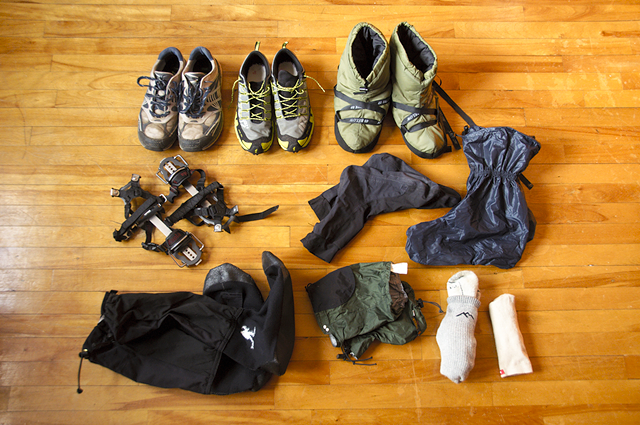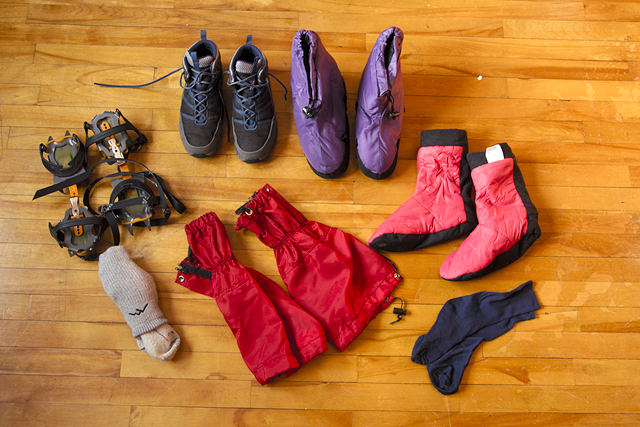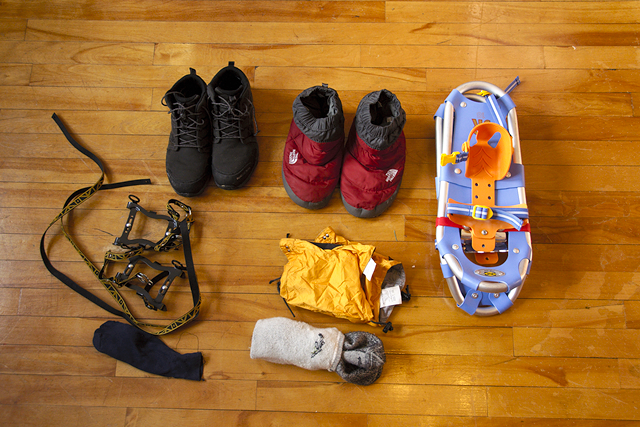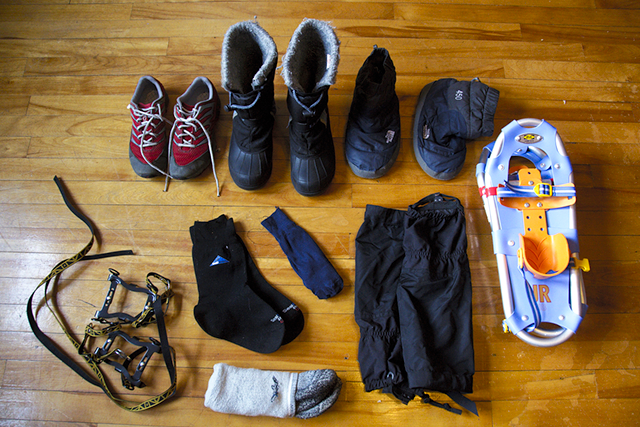I frequently get asked what I recommend as minimalist footwear for cold weather use. I will be perfectly honest and say that I don't have an established system that I whole-heartedly endorse as of yet. It is a work in progress for us, there is a lot of experimentation going on (I LOVE experimentation!). As long as I promise to resolve any issues that arise through the scientific process, my family is OK with their roles as lab mice.
That said, this post is an overview of where we are at right now. The systems listed here can and will change as we learn what works and what doesn't. Don't take anything here as gospel truth, I will not be held responsible for how you use this information. It is my hope that as we continue to experiment and refine our systems, that I will feel more comfortable with making solid recommendations in future posts.
Here is what I am aiming for:
- Minimalist: I am looking for our footwear to be as minimalist as possible (in case you haven't noticed already, I am kind of an idealist in that regard). If you don't know what that means, you can learn more here.
- Ultra-Light: I am a believer in using ultra-light techniques for backcountry travel. If you don't know what that means, you can learn more here.
So without further ado, here is a pile of data and notes for you to sift through at your leisure...
Damien's Gear

- GoLite Amp Lite shoes: One of two pairs of shoes I will be testing as the base for my winter footwear system. They sport a nice big toebox, and no raised heel. Sized one full size larger than normal for wearing extra layers of socks.
- Inov-8 Oroc 280 shoes: The other pair of shoes I will be testing. Lighter-weight than the GoLites, the Orocs have a 6mm raised heel, a smaller toebox, and tungsten carbide studs on the sole. As with the Amp Lites, they are sized one full size larger.
- 40 Below booties: For use around camp, in tents/cabins, and for sleeping in very cold conditions.
- Katoolah KTS Steel crampons: Light-weight, and very flexible, these crampons are a good compliment to trail runners.
- Rocky Gore-Tex socks: For keeping my socks dry in non-waterproof trail runners. I really don't like how narrow these fit, I wish someone would design a Gore-Tex sock that had a more anatomical shape.
- Integral Designs VB socks: I am a newbie to the usage of VB clothing, but so far the results have been favorable. If they work out, I will likely be setting up other family members with VB socks as well.
- 40 Below Light Energy TR overboots: For wearing over trail runners in very cold conditions. They come with a built-in high gaiter. A perfect companion to snowshoes.
- Integral Designs Shortie gaiters: Constructed out of waterproof/breathable E-Vent fabric, these are for use with the trail runners when not using overboots.
- Darn Tough Vermont Mountaineering socks: Tough, thick, and warm.
- Injinji liner socks
What is missing from my list are snowshoes, as I currently don't own any. At the moment if I need them, I borrow them.
Renee's Gear

- Inov-8 Roclite 390 GTX boots: These boots are not exactly minimalist, they have too much heel, too much cushioning, and limit ankle flexibility. That being said, they work very well at keeping my wife's feet warm and dry. Warm and dry trumps minimalist and cold. We bought large to accommodate extra layers of socks.
- 40 Below booties
- Integral Designs Hot Socks: For those times when the booties are too much insulation, the Hot Socks work great.
- Black Diamond Contact Strap crampons: A little heavier than the KTS crampons, these ones are a lot easier to adjust for varying sizes of footwear.
- Generic gaiters: We bought these at MEC in Canada years ago and they still work great.
- Wigwam Gobi liner socks: Basic, no-frills liner socks. Work great.
- Darn Tough Vermont Mountaineering socks
As with me, Renee doesn't have any snowshoes yet either, but borrows them as required.
Celine's Gear

- Inov-8 Roclite 288 GTX shoe: Lighter weight, more flexible, with less cushioning, and less heel than the 390 GTX. As with the 390, these are waterproof and breathable. They are a small women's size which means that they have ample room for Celine to fit extra sock layers inside comfortably. We transitioned Celine to light-weight trail runners last year because she found that kids winter boots made her feet hurt after a few hours when hiking/snowshoeing. Moving her to a more minimalist shoe fixed the problem. This year we decided to try Gore-Tex ones.
- The North Face down booties: A couple years ago we bought all our kids a pair of these for Christmas. They love them.
- Atlas Jr. snowshoes: They like wearing them for about fifteen minutes before they start to complain about them being too heavy.
- Petzl Crab 6 crampons: Great little 6 point crampons that can be sized to fit any shoe or boot, including kids.
- Integral Designs Shortie gaiters
- Wigwam Gobi liner socks
- Darn Tough Vermont Mountaineering socks
Laurent's Gear

- Inov-8 Roclite 285 shoes: Light weight trail runners with a low heel and minimal cushioning. Sized in a women's small size, they fit big to allow for extra sock layers. Hand-me-downs from Celine.
- L.L. Bean winter boots: Hand-me-downs from friends, these are waterproof and warm for when the trail runners just wont cut-it. Definitely not minimalist.
- The North Face down booties
- Petzl Crab 6 crampons
- SealSkinz waterproof socks: Cheaper than Gore-Tex, but we have found that they don't perform nearly as well either.
- Wigwam Gobi liner socks
- Darn Tough Vermont Mountaineering socks
- EMS knee-high gaiters: We bought these in the smallest adult size available. We don't really like they way they are designed, and they can be quite difficult to put-on. We may be replacing these in the not-too-distant future.
- Atlas Jr. snowshoes
Brienne's Gear

- Keen winter boots: Hand-me-downs from Laurent, these will be her cold-weather winter boots. Warm, but not minimalist. These will be used when the trail runners aren't enough.
- Inov-8 X-Talon 160: The kids version of the X-Talon 212, these have very little cushioning, and hardly any raised heel. A very minimalist trail runner with a great tread. We sized them up for wearing with thick socks.
- The North Face down booties
- Petzl Crab 6 crampons
- SealSkinz Chillblocker waterproof socks: Hand-me-downs from Celine. Waterproof/breathable socks with a soft fleecy lining. The problem is that they aren't all that waterproof, or that breathable. They are also very thick, making it difficult to get a good fit in shoes. They probably won't see a lot of use this year.
- Wigwam Gobi liner socks
- Darn Tough Vermont Kids Cushion Boot socks
- Outdoor Research Flex-Tex gaiters: Out of all the gaiters we have tried for the kids, these ones are hands-down the best so far. They are easy to put on, they fit well, and they stay-put.
Brienne outgrew her snowshoes last year. We may do some snow-shoe shuffling this year, giving her Celine's and getting Celine a larger pair.

Comments
Do you know what insulation
Do you know what insulation the 40 Below booties use? They don't seem to say on their website.
No, I don't know what
No, I don't know what insulation they use, it isn't stated anywhere that I have seen.
daily wear shoes
I'm curious what you wear on a daily basis. Presuming that it's also minimalist, I wonder how you combine comfort and warmth. I would love to have some good minimalist shoes that I can wear as I go to work and school, that will also serve to keep my feet warm during the winter weather.
On a daily basis, I will use
On a daily basis, I will use everything that you see above as required. When I get to work, I will slip on summer-weight minimalist shoe for the office. I generally don't wear different shoes for my daily life than I do for the trail.
Waterproof socks
I can see you use Golite Amplite shoes. Recently I received Golite Timberlite shoes from the US for winterwear. So far I used them only once. In the beginning it felt like 'standing backwards' because I was missing the heel lift that I was used to. Now I love the better posture and the relaxed way of walking. Without a heel it feels like I can raise my feet less with every step.
I also own the Vivo Barefoot Aqueous waterproof walking shoe for cold and wet weather. For real winter use they will not be usable because of the thin sole. But their good for fall and spring use.
You don't like the shape of your Gore-Tex socks. Lizard Footwear will come with the waterproof Storm Sock Hi. It has an elastic textile with a waterproof and breathable membrane and really looks like a good sock.
Thanks for the info Huib, I
Thanks for the info Huib, I had never heard of Lizard Footwear before, I will definitely check them out. I noticed they also make toe-socks too, which is interesting to me because I like to wear toe socks in the summer.
I had an early pair of the Timber Lites that I was testing. They had a flaw in the membrane (which they have since fixed in the production version) that caused them to leak around the base of the tongue. I threfore can't wear those ones, but may end up getting another pair if I need a waterproof shoe.
Damien, I was wondering about
Damien, I was wondering about the VB socks, and what their purpose is, especially if you are wearing wool socks with gore tex booties.
I was also curious about the crampons. What is the minimum/maximum amount of snowfall that they work well in?
Thanks,
John
VB Clothing
Hello John,
I highly recommend reading this excellent and thorough article by Andrew Skurka on the usage of VB clothing: http://www.andrewskurka.com/advice/technique/vaporbarrierliners.php
With regards to the crampons, it really doesn't have much to do with snowfall, but ice. If you are going to be hiking steep icy trails, crampons are necessary. If you are going to be on flat icy trails, then you can get away with something like microspikes or yaktrax. If you are going to be in deep snow, then you will probably want skis or snowshoes.
Interesting. We've used
Interesting. We've used lightweight trail runners for many years in summer, but they never seem nearly as practical in winter. Snowballs in the laces, snow getting in the sides, slush or stream crossings soaking then freezing them, etc... Perhaps I'm just not religious enough about using gaiters every time I go outside. Around the house I've just been using rubber boots in winter, which aren't great for hikes either. Interested to see how well this ends up working for you.
What about a high-top
What about a high-top gore-tex trail runner such as the Inov-8 Roclite 390 GTX or the X-Talon 288 GTX. That is what BPL is recommending these days, that and a high gaiter. The high-top runners are high enough that they work alright for running in and out of the house without a gaiter... then you can add the gaiter for more serious trekking.
This is a great post. I loved
This is a great post. I loved wearing my 5 Fingers all summer, but around 40F my feet were freezing! It's hard to imagine trail runners will be warm enough in the snow, even with socks, but it sounds like it works for you. I may have to give it a shot.
Be warned that some of this
Be warned that some of this is experimentation! (Based on some other stuff we have read)... don't take these recommendations as absolute truth! That being said, I read a lot of people having good luck with waterproof trail runners (oversized) combined with a gaiter and thick socks for winter use. Add an overboot for really cold conditions...
Great post - very interesting
Great post - very interesting to compare the different gear. I'm just upgrading my winter kit so this was very helpful. I'm not that keen on VB layers, so might try some sealskins and/or the outer boots from 40 Below. Cheers!
Pingback
[...] Footwear For Fall/Winter/Spring (testing) - An evolving footwear system [...]